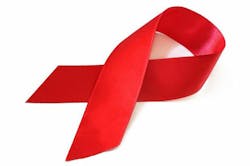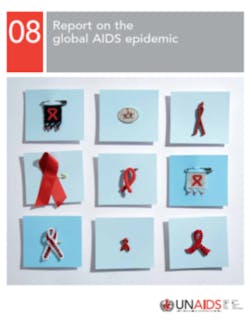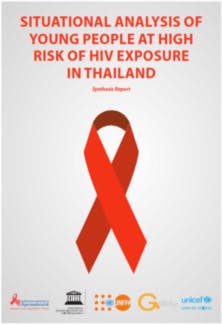A still deadly disease is HIV infection and AIDS. A projected 70% of new sexually transmitted infections cases are occurring among young people, especially among men who have sex with men, those involved in sex work, and those who inject drugs in Thailand. Some believe that social media, online dating websites, and mobile applications make it much easier for young people to meet others in order to engage in casual sex.
Assembled by the UN Children’s Fund (UNICEF), the new study, “Situational Analysis of Young People at High Risk of HIV Exposure in Thailand,” collected data from about 2,000 young people, including men who have sex with men, transgender persons, females who exchange sex for money, migrant workers, and people who inject drugs in four provinces. The highest number of sexually transmitted infections (STIs) and unwanted pregnancies in Thailand are among 15-24 years old age group, suggesting that safe sex messages are not reaching this age group. Read the report for more information.1
The International Technical Guidance on Sexuality Education is based on a rigorous review of evidence on sexuality education programs and is intended for education and health sector decision-makers and professionals.2 In many parts of the world, a combination of social taboos, unavailability of sound information, lack of resources, and infrastructure make it problematic for children and young people to access sexuality education intended to improve knowledge and reduce risk. This leaves many young people vulnerable to coercion, abuse, exploitation, unintended pregnancy, and sexually transmitted infections, including HIV. The International Technical Guidance on Sexuality Education is available in Arabic, Chinese, English, French, Portuguese, Russian, Spanish, and Thai.
According to the UNAIDS 2008 Global Report on the AIDS Epidemic, only 40% of young people aged 15-24 had accurate knowledge about HIV and transmission.3 Due to this experience of insufficient levels of basic knowledge, young people aged 15-24 account for 40% of all new HIV infections.4
One of the things suggested for early detection of HIV infection is testing in the dental office. Dentists in South Korea have already begun regularly offering HIV tests, and so have a few in Canada, Mexico, and the United States. One study used data from the 2005 National Health Interview Survey to observe the possible role of dental care in reaching untested individuals at self-reported risk for HIV.5 An projected 3.6 million Americans report that they are at significant HIV risk yet have never been HIV tested. Three quarters of these people have seen a dentist within the past two years. Dental care offers opportunities to serve at-risk individuals who are otherwise unlikely to be tested or to receive preventive care services.
Most dental patients are open to receiving an HIV test in a dental office. One paper reported the results of qualitative interviews with 19 adults attending a university-based dental clinic in New York City.6 Overall, patients held very positive attitudes and beliefs toward HIV screening in dental sites and identified important factors that should be incorporated into the design of nurse-dentist collaborative HIV screening programs. Rapid oral HIV testing in the dental practice setting is a good way to reach a proportion of the population not currently accessing primary care in more traditional medical settings.
Another study showed that more than 80% of oral health patients are willing to receive rapid HIV-testing in dental settings, which could help reduce the spread of the HIV.7
OraQuick Advance
Dental offices could use oral HIV tests that detect antibodies that the immune system releases to attack HIV. One device, the OraQuick Advance, is a paper strip coated with harmless amounts of HIV antigens.8 It’s used to swab the cheeks and gums. A health provider then dips the strip in a vial filled with an enzyme solution that reacts to HIV antibodies in oral fluids, producing a solid line on the strip to indicate a positive result. No antibodies, no line. The test takes around 20 minutes. One study stated that dental hygienists could administer the test, most likely at the start of an appointment, with results given at the end.9 Since a positive result doesn’t necessarily indicate HIV status, the dental hygienist would then refer positive-testing patients to a primary-care doctor for further testing. Santella and his group propose testing an HIV test kit at three dental hygiene clinics in New York City.9
References
- The School of Global Studies, Thammasat University, Rangsit Campus. Situational Analysis Of Young People At High Risk Of HIV Exposure In Thailand: Synthesis Report. http://www.unicef.org/thailand/UNICEF_study_on_HIV_infection_among_young_peole_FINAL_ENGLISH.pdf.
- http://www.unesco.org/new/en/hiv-and-aids/our-priorities-in-hiv/sexuality-education/international-technical-guidance-on-sexuality-education/.
- http://www.unaids.org/en/media/unaids/contentassets/dataimport/pub/globalreport/2008/jc1510_2008globalreport_en.pdf.
- UNAIDS 2009 AIDS Epidemic Update. http://data.unaids.org/pub/report/2009/jc1700_epi_update_2009_en.pdf.
- Pollack HA, Metsch LR, and Abel S. Dental Examinations as an Untapped Opportunity to Provide HIV Testing for High-Risk Individuals. Am J Public Health. 2010 January; 100(1): 88–89. doi: 10.2105/AJPH.2008.157230.
- VanDevanter N, Malamud D, Combellick J, and Shelley D. A Qualitative Study of Patients’ Attitudes toward HIV Testing in the Dental Setting. Nursing Research and Practice, Volume 2012, Article ID 803169, 6 pages. doi:10.1155/2012/803169.
- http://sydney.edu.au/news/84.html?newscategoryid=1&newsstoryid=13774.
- http://www.orasure.com/products-infectious/products-infectious-oraquick.asp.
- Santella A. Davide SH, Cortell M, Furnari W, and Tuthill J. The Role of Dental Hygienists in Conducting Rapid HIV Testing. The Journal of Dental Hygiene, Vol. 86, No. 4, Fall 2012, 265-271.










